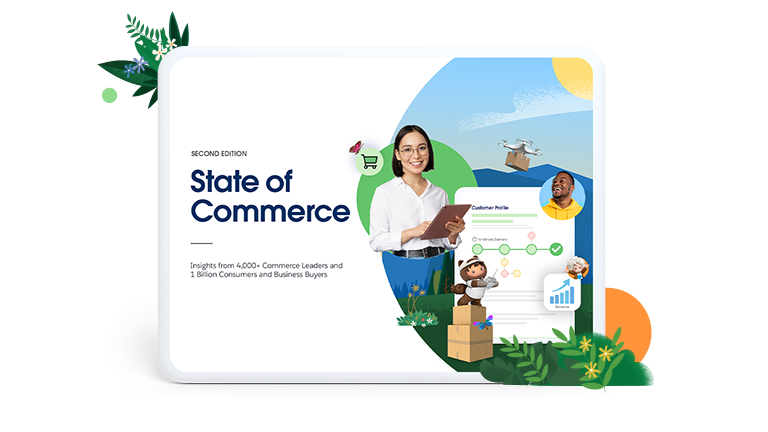E-commerce is central right now across B2B and B2C. In the UAE alone, it’s a $1.7B market – net sales have increased by 85% from 2018 to 2020 and the market is touted to reach $8B by 2025. This shift adds up to opportunities – and not just for e-commerce brands. Everyone from traditional retailers to B2B brands is getting involved. UAE grocery chain Lulu is building its digital presence and selling directly to consumers, while nearly half of business executives in Saudi Arabia and the UAE say they buy most of their supplies online.
Our recent State of Commerce report surveyed 4,000 commerce professionals (including your peers in the UAE) and 1 billion customers. It shows how customer attitudes and behaviours are evolving and how companies are reacting.
Keep reading to get some actionable insights from the report on how to:
- Add and unify new channels to drive value for customers
- Mine the actionable data to personalise engagement
- Reinvigorate your focus on agility
- Use digital commerce to augment traditional sales channels
Ready? Let’s go.
State of Commerce Report
Get a pulse on what over one billion customers think, and how 4,000+ commerce professionals are meeting new expectations, market conditions, and revenue opportunities.

Drive digital success with new channels
As digital commerce evolves, companies are chasing revenue in new ways. They’re investing in new channels like TikTok and the Metaverse, and turning traditional touchpoints like customer service into sales channels.
Digital commerce opens up new channels for revenue. Brands use these channels to personalise customers’ online and offline experiences with tailored suggestions and offers that drive revenue from these novel sources and deliver the convenience customers are hungry for. Brands are also providing more flexibility to their customers. Worldwide, 85% of B2C companies reported they either have already or will implement ‘buy online, pick up in-store’ services in the next two years.
Customers are pushing companies to become more digitally savvy as they buy in increasingly non-linear patterns. For instance, customers are making more complex purchases on a desktop, yet reordering routine purchases by mobile phone, or researching purchases online but then making them in person. And, this goes for customers in the UAE: 84% have used multiple methods of communication to start and complete a single transaction.
Even with complex and distributed buying habits, you need to provide a coherent experience. The majority of customers said they felt loyal to companies that provide a consistent experience across departments – but 60% of customers worldwide say it feels like they’re communicating with separate departments instead of one company, according to our 2022 State of the Connected Customer report.
The B2B sales funnel is changing too. Buyers look at different product aspects and gather information from multiple sources, and it’s often spread across different people on the buying committee. But even across fragmented touchpoints, they seek consistency – it builds trust, and trust is essential for placing online orders.
Unlock actionable data to drive personalised engagement
Selling across digital channels gives organisations an advantage – including a treasure trove of customer data. First-party customer data is a golden source of actionable insights to make marketing that customers remember. But with cookie deprecation around the corner, personalised marketing is going to get harder. While 85% of UAE commerce pros report they’re good at using data to personalise customer experiences right now, they’re also worried that the loss of cookies and new data privacy regulations will compromise their data pipeline. Tellingly, digital leaders are the most concerned about losing this access.
In the UAE, 43% of customers prefer fast shipping and 27% want to have the item the day they order it. Even B2B brands are getting into the game – 51% of global B2B buyers report using curbside pickup more than they did a year ago. To meet these demands, 55% of executives globally say they’ll prioritise optimising the entire fulfilment journey.
The rise in payment options and buying channels increases the odds of a disjointed experience – and that doesn’t cut it anymore. Customers expect consistent experiences across service, commerce, and marketing touchpoints. A huge majority of customers in the UAE – 92% – say the experience a company provides is as important as its product or services.
Renew focus on agility
Customers across B2B and B2C are shrewd, tech-savvy value-seekers. They want fast, convenient digital experiences built around their needs and preferences. But the good news is that elevated customer expectations aren’t just a higher barrier to entry. There’s a direct line between meeting new desires and unlocking new revenue.
In short, the ask is bigger, but so is the reward. While 98% of the top B2C stores in the UAE online offer credit card payments, today’s customers expect more options at checkout than cash or credit card. They want to use e-wallets (like PayPal), Apple or Google Pay, instalment options, or pay with loyalty points. Give them more ways to buy, and they’ll use them. As new options lure customer dirhams and build loyalty, organisations are investing in flexibility to provide even more choices. In the next two years, 32% of brands in the UAE expect to offer buy now, pay later options.
Interestingly, cryptocurrency is making faster inroads in the UAE than in other countries. Already, 31% of commerce professionals in the UAE offer it as a payment option, and another 67% plan to within the next two years – meaning crypto will soon be near-universal in the UAE. Worldwide, 76% offer or will offer this option within two years. But there’s a barrier to the promise of flexibility: technology limitations.
There’s a gap between intent and effect. Companies want to offer more payment and pickup options (and personalised marketing and product offerings in response), but legacy tech can be restrictive. Globally, 34% of organisations say it takes weeks at minimum to make changes to their digital storefront – a result of a complicated backend experience. And the harder this gets, the more attractive headless architecture becomes. By decoupling back-end structures from the front end, you get way more flexibility.
In the UAE, a strong majority of commerce professionals cited the ability to customise digital experiences as the top benefit. It helps companies make changes to storefronts, add new channels like voice search and virtual reality, and integrate systems to provide a more unified and better customer experience. Companies that have adopted headless architecture are more likely to rapidly expand into new channels (77%) than non-headless companies (54%) – and this is key to driving growth and improving customer experience.
Use digital commerce to augment traditional sales channels
Who knew? When new meets old – or digital commerce meets traditional sales – they make each other better. At least, that’s what commerce professionals say: 93% of global organisations are maintaining or increasing their sales teams.
How do human-powered sales and digital commerce work together? Well, digital commerce makes selling faster, providing marketing support that warms and helps qualify leads, and sharing insights into what those leads care about. Digital interactions like video, messaging apps, and document collaboration are replacing some real-time meetings to accommodate different time zones and busy schedules. And the results? Companies that combine digital in-person sales reported at least a 10% faster time to close.
Digital commerce also improves the seller experience by automating a lot of previously manual work so they can focus on high-value interactions. Globally, 60% of B2B sellers report that digital commerce improves sales team members’ job satisfaction. This in turn helps retain talent, a key value driver as B2B sellers take a long time to learn their products inside-out. (And we don’t need to tell you how often they get poached by competitors.)
The global e-commerce market is enormous and growing
The global e-commerce market was worth $2.5 trillion US in 2020, and the UAE market is growing especially fast. But success requires ongoing transformation to meet the ever-changing needs of the only stakeholder who really matters: your customer.
The world is increasingly digital-first, and customers crave the convenience and personalisation that e-commerce provides. Understanding what customers want most – and what other brands are investing in – can help businesses make the right investments to expand their customer bases.
State of Commerce Report
Get a pulse on what over one billion customers think, and how 4,000+ commerce professionals are meeting new expectations, market conditions, and revenue opportunities.
























